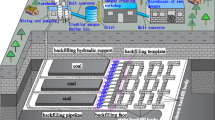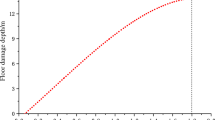Abstract
In underground mining, floor failure depth accompanying mining phases usually results from changes in the advance abutment pressure in the coal mass, and changes in stress redistribution in the areas that have already been mined. Although a variety of techniques have been applied to determine the failure depth, and a number of studies have provided the evidence for the decreasing of failure depth under backfilling, these methods and interactions have not been unequivocally identified. Based on the premise of one possible relation between the failure depth and filling body, which is that the filling materials (gangue) in the gob area can not only restrain the movement of the overlying strata effectively, but also can help to decrease failure depth of the floor in the coal mine. The failure depth in a specific longwall gangue backfilling mine was measured using the mine electricity profiling method. These electrode cables are arranged in a crossheading order to measure the depth and position of the destroyed floor using the DC method. After this, several different methods were used to interpret the recorded data from the field study for gaining failure depth, and the results were compared to the theoretical calculation values. And finally, the authors analyzed the reasons for failure depth form values recorded not indicating a large decrease trend when compared to the theoretical calculation. In this area, it is found that: ① The results using the mine electricity profiling method turns out to be robust and can be used in predicting floor failure depth, and the horizontal position of the maximum destroyed in working face of longwall backfilling. The maximum destroyed position and failure space of the floor can be identified by using this method. ② There is a time-delay processing between the advance of the working face and the failure of floor strata in the mining processing. ③ Additionally, based on the data collected from field measurements, which includes three different test electrode spacing approaches (single, double and triple electrode spacing), and the theoretical value from theoretical calculations. The premise mentioned above cannot be supported during the specific field test, and the role of the filling body in the mined area cannot decrease the floor failure depth effectively in comparison to the theory predictions. Basically, the failure depths in the two different methods have similar results and it is possible that there will not be a direct correlation between the filling body and failure depth. ④ Although the failure depth cannot decrease effectiveness when using gangue backfilling in the field testing, due to gob gangue, filling materials being able to deliver the abutment pressure from the overburden in most cases, once they were compacted and rammed by the overburden pressure, it still can make the fracture of the gob area clog and be further consolidated. In this way, it is assumed that water-bursting accidents can be prevented effectively under backfill mining. For this reason, gangue backfilling may make a significant contribution to safety mining.
Similar content being viewed by others
References
Dobroka M, Gyulai A, Csokas J, 1991. Joint inversion of seismic and geoelectric data record in an underground coal mine. Geo-physical Prospecting, 39(5): 643–665.
Feng M M, Mao X B, Bai H B, 2009. Experimental research on fracture evolution law of water-resisting strata in coal seam floor above aquifer. Chinese Journal of Rock Mechanics and Engineering, 28(2): 336–341.
Gao Z N, Meng X R, Zhao G M, 1997. DC electrical resistivity CT survey of deformation and damage law of coal floor. Journal of Chongqing University, (4): 34–35.
Li J H, Xu Y C, Zhang B, 2004. Water inflow forecast from roof and floor in the deep area of No.1 panel. Coal Mining Technology, 8(1): 66–68.
Shi L Q, Zhu L, Han J, 2004. Monitor study on broken floor depth caused by underground pressure. Coal Geology & Exploration, 32(6): 20–23.
Wang J C, Xu Y C, Xu G M, 2010. Application of mine electric profiling method to detect floor failure depth of coal mining face. Coal Science and Technology, 3(1): 97–100.
Wang L G, Song Y, 2000. A catastrophic model of water-inrush from coal floor. Journal of Engineering Geology, (2): 161–163.
Wang L G, Song Y, Miao X X, 2003. Study on prediction of water-inrush from coal floor based on cusp catastrophic model. Journal of Rock Mechanics and Engineering, (4): 263–267.
Zhong G S, Jiang W W, Xu G Y, 2007. Prediction of water inrush from floor based on catastrophe theory. Journal of Liaoning Technical University, (2): 216–219.
Author information
Authors and Affiliations
Corresponding author
Additional information
Supported by the National Natural Science Foundation of China (51104162); the Open Foundation of State Key Laboratory of Coal Resources and Safe Mining of China University of Mining and Technology (SKLCRSM10KFB10)
Rights and permissions
About this article
Cite this article
Yang, SL., Ding, XP., Wang, X. et al. Analysis of floor failure depth by using electric profiling method in longwall gangue backfill mining. J Coal Sci Eng China 19, 282–289 (2013). https://doi.org/10.1007/s12404-013-0303-4
Accepted:
Published:
Issue Date:
DOI: https://doi.org/10.1007/s12404-013-0303-4




